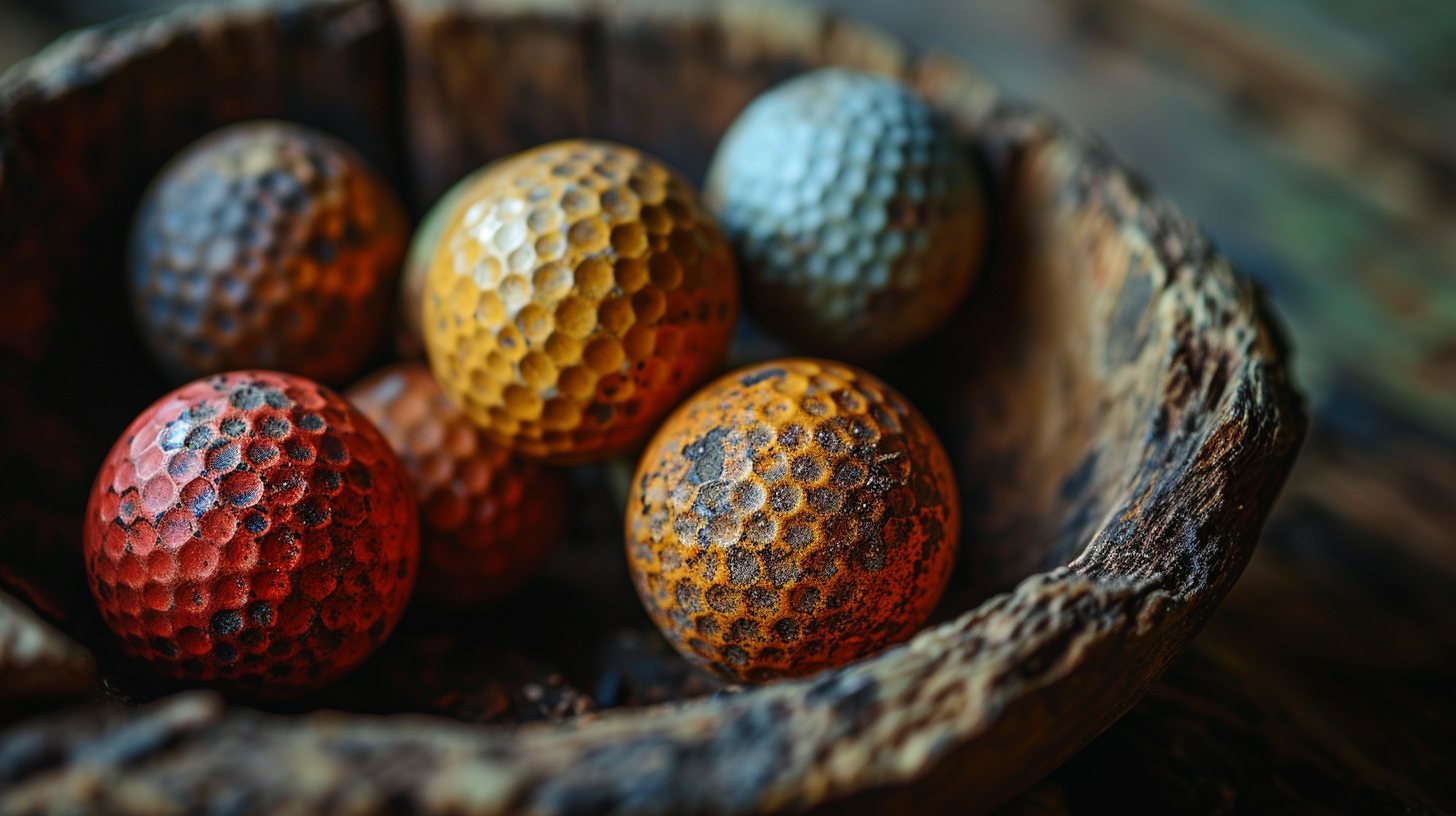Golf balls may seem simple, but inside they hide an intricate, high-tech mix of materials and layers.
From their early days as stitched leather pouches stuffed with feathers to today’s precision multi-layer spheres, golf ball components have undergone an impressive evolution to optimize flight performance.
Let’s peel back the covers and dive inside the anatomy of a modern golf ball to uncover what leads to straight drives, soft wedges, and smooth putts.
History of Golf Ball Materials

Golf balls have come a long way since the early days of the sport. In the beginning, golf balls were made of various materials often found in nature.
One of the earliest recorded golf balls dating back to the 17th century consisted of feathers stuffed tightly into a small leather pouch that was stitched together. These feather golf balls were in use for over 300 years.
However, they lacked durability and symmetry.
In 1848, the Gutta-percha golf ball was introduced. This ball was made from the dried sap of the Gutta-percha tree found in Southeast Asia.
The sap was heated and molded into a golf ball shape. The Gutta-percha golf balls were much more durable than the old feather balls and soon became the standard golf ball used in play.
They allowed the game of golf to grow in popularity during the mid 19th century.
By 1900, golf ball manufacturers started experimenting with rubber material. In 1900, Coburn Haskell introduced a rubber-cored golf ball with a gutta-percha cover called the Haskell ball.
This ball marked a major breakthrough in golf ball development though the outer gutta-percha cover still left much to be desired as far as performance.
In the early 1900s, the Balata golf ball started gaining traction which would dominate the golf market for much of the 20th century until urethane covers and multi-layer balls took over. The Balata golf ball cover is made from the sap of the Balata tree.
This softer cover provided much better spin control around the green and a softer feel preferred by the professionals and better amateur players.
Modern Golf Ball Materials

Today’s golf balls have evolved tremendously, incorporating cutting-edge materials and manufacturing processes to optimize performance.
Modern golf balls feature multi-layer construction with precisely engineered cores, interior layers, and outer covers working together to achieve desired playing characteristics. Let’s take a closer look at some of the key materials found inside and outside of contemporary golf balls.
Surlyn and Ionomer Covers
Many 2-piece distance balls and some 3-4 piece golf balls utilize a cover material made from Surlyn. Surlyn is a thermoplastic resin that provides great cut resistance and durability to the exterior of the golf ball.
However, some golfers complain that Surlyn-covered balls generate an unpleasant, almost plastic-like feel coming off clubface impacts, especially with the wedges and putter.
Ionomer covers represent a slight upgrade over the regular Surlyn covers. Chemically, Ionomers are close cousins to Surlyn as they are metal salts of certain copolymers.
Ionomer covers offer a little better feel and control than the standard Surlyn without sacrificing the cut resistance too much.
Most recreational and aspiring amateur players gravitate towards the golf balls with the ionomer covers for balanced performance across all facets of the game.
Urethane Covers
The vast majority of premium, tour-level golf balls for the advanced players utilize a thermoset urethane cover which provides superior performance to ionomer or Surlyn covers. Urethane covers foster a tremendously soft feel on full iron and wedge shots.
They also promote excellent greenside spin control on pitch and chip shots. Urethane covers are also quite durable these days, making them a popular choice on the professional tours.
The urethane cover formulation does vary among golf ball manufacturers using different chemical processes and additives to optimize specific playing attributes and further differentiate their offerings in the highly competitive golf ball market.
Solid Core Types
One-piece golf balls meant primarily for beginners, novices, or casual fair-weather golfers out having fun usually have a solid synthetic rubber or plastic core.
These inexpensive, almost indestructible balls roll and fly pretty straight but do not generate much spin or feel around the greens.
In essence, they get the basic job done for golfers not worried about maximizing control or scoring performance.
Most modern two and multi-layer golf balls utilize thermoplastic solid cores engineered for superb resilience and consistency across a wide temperature range.
Many ball manufacturers incorporate special chemical formulas and additives to further enhance the solid core’s performance. Splitting the core into two or more distinct layers wrapped around each other enables additional customization of playing characteristics.
Wound Cores
Wound cores consist of a liquid or solid center that has thin rubber thread tightly wrapped around it numerous times in specific patterns. The winding patterns and materials determine the spin, launch, and feel produced.
In the past, wound construction was preferred by better players for the soft feel and added spin it generated relative to two-piece balls.
However, with recent major advancements in multi-layer solid core formulations, wound cores have become less prevalent among the tour caliber balls.
Most recreational and aspiring amateur level balls do still utilize wound cores with ionomer or Surlyn covers to provide a good value performance combination.
High-end urethane covered balls targeted towards advanced players predominantly rely on cutting-edge multi-layer solid core constructions to maximize distance while having enough spin and control coming into the greens.
But manufacturers sometimes will integrate a layer or two of wound rubber wrapping strategically within the core to influence the ball flight performance.
Multi-Layer Core Construction
Modern premium golf balls contain intricately engineered multi-layer cores allowing designers to modify the spin rates, launch angles, ball velocities, and feel across the full spectrum of full swing and short game shots.
Constructing cores containing two, three, four, or even five distinct layers enables extensive fine-tuning of playing characteristics.
Manufacturers utilize diverse formulations and materials within the individual layers including various thermoplastic blends, synthetic rubbers, chemical additives, and fillers.
The composition, thickness, and sequence of the layers all significantly impact forces transferred to the ball at impact and its subsequent response coming off the clubface.
Testing out prototype iterations with professional players further aids selection of optimal layering arrangements.
Surrounding the multi-layer core are often one or more intermediate mantle layers followed by the outer urethane cover.
Extensive research and player testing goes into formulating the chemical makeup of these layers to synergize with the core construction to produce desired playing attributes. Slight variation in materials or thicknesses noticeably influences the end product’s performance.
Conclusion
Modern golf balls represent a pinnacle of research and engineering incorporating an intricate mix of materials strategically configured to help all levels of golfers shoot lower scores.
Manufacturers continue pushing multi-layered development leveraging diverse advanced materials to incrementally eke out any possible yardage gains or finesse the aerodynamics, spin rates, and feel across every type of shot from the tee through the green.
Testing processes and quality control ensures tight production tolerances so golfers can rely on consistent results from their favorite ball model.
While we’ve come a long way from feathery leather pouches, there remains plenty of room for more evolution when it comes to optimizing what lies at the heart of the game.



